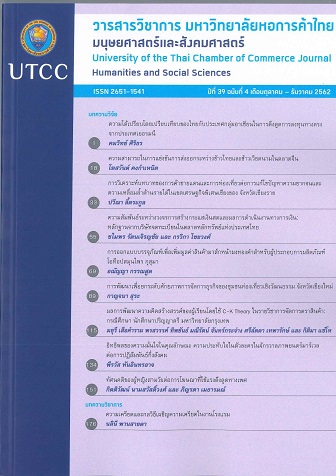Attitudes of Females from Three Generations towards Advertising Using Sex Appeal
Main Article Content
Abstract
This research’s objective is to study females’ attitudes towards advertising using sex appeal. This research is the qualitative research with in-depth interviews of 9 female informants from 3 generations: Gen X, Gen Y and Gen Z. The result shows that women from different generations has different attitudes towards advertising using sex appeal. Gen X emphasizes on affective component while watching the advertisement. Using male model can attract the attention of Gen X the most. Using female model can create product and advertising preference and create product demand for Gen X. However, the advertiser should avoid nudity and any forms of blatant and obvious sexual appeal in advertising to Gen X. Gen Y focuses on the appearance of the model. More sophisticated sexual appeal can create a sense of passion for the product and the advertising. Using non-nudity female model can create demand for using the product of Gen Y. On the other hand, Gen Z focuses on the product information rather than the human model in the advertisement, especially when the advertisement can attract interest or stimulate thought and interpretation. Forms of more sophisticated sexual appeal can attract the attention, build preferences and create demand for trying the product of Gen Z. Marketers should avoid using any forms of blatant and obvious sexual appeal or presentations focusing on specific gender in advertising rather than giving information of the product for Gen Z.
Article Details
ลิขสิทธิ์ของบทความ
ผลงานที่ได้รับการตีพิมพ์ถือเป็นลิขสิทธิ์ของมหาวิทยาลัยหอการค้าไทย ห้ามมิให้นำเนื้อหา ทัศนะ หรือข้อคิดเห็นใด ๆ ของผลงานไปทำซ้ำ ดัดแปลง หรือเผยแพร่ ไม่ว่าทั้งหมดหรือบางส่วนโดยไม่ได้รับอนุญาตเป็นลายลักษณ์อักษรจากมหาวิทยาลัยหอการค้าไทยก่อน
References
ธนชัย วิทยาคุณสกุลชัย. (2541). การวิเคราะห์ "เซ็กซ์ แอพพีล" ในภาพโฆษณาทางนิตยสาร (วิทยานิพนธ์ปริญญามหาบัณฑิต ไม่ได้ตีพิมพ์). จุฬาลงกรณ์มหาวิทยาลัย, กรุงเทพฯ.
นาถฤดี เด่นดวง. (2554). เพศ (Sex) บทบาทความสัมพันธ์หญิงชาย (Gender) และความเสมอภาคระหว่างหญิงชาย (Gender Equality). กรุงเทพฯ: สำนักส่งเสริมความเสมอภาคหญิงชาย.
พิชญา เพ็งจันทร์. (2557, มกราคม-กุมภาพันธ์). อิทธิพลของครอบครัวต่อเด็ก Gen Z. Read Me Egazine. 28, 14-15. สืบค้นจาก https://readme.tkpark.or.th/download/readme28.pdf
เมทิกา ชาติน้ำเพ็ชร. (2557). กลุ่มอิทธิพลทางความคิดที่มีผลต่อการเลือกซื้อสินค้า search, experience และ credence ของ Generation B, Generation X และ Generation Y (วิทยานิพนธ์ปริญญามหาบัณฑิต ไม่ได้ตีพิมพ์). มหาวิทยาลัยธรรมศาสตร์, กรุงเทพฯ.
โรงพยาบาลบำรุงราษฎร์, ศูนย์สูตินรีเวช. (2559). วัยทอง. สืบค้นเมื่อ 21 มกราคม 2562, จาก https://www.bumrungrad.com/th/women-center-health-obgyn-bangkok-thailand/procedures/menopause-hormone-treatment
Supanut Praphin. (2555). การเก็บรวบรวมข้อมูล: เครื่องมือ. สืบค้นเมื่อ 25 มกราคม 2562, จาก https://www.gotoknow.org/posts/460725
Chuenchomeboon, P. (2010). Sex appeal in Thai advertising film (Unpublished master’s thesis). Thammasat University, Bangkok, Thailand.
Khan, N., & Sanchez-Munoz, D. (2015) To what extent does sex appeal in advertising influence female consumers' attitudes and final purchasing intentions? A cross-cultural investigation. In Proceedings of the 14th International Marketing Trends Conference, January 23-25, 2015. Retrieved from https://archives.marketing-trends-congress.com/2015/pages/PDF/113.pdf
LaTour, M. S., Pitts, R. E., & Snook-Luther, D. C. (1990). Female nudity, arousal, and ad response: An experimental investigation. Journal of Advertising, 19(4), 51-62.
McLeod, S. A. (2018). Attitudes and behavior. Retrieved January 21, 2019, from https://www.simplypsychology.org/attitudes.html
Millwardbrown, K. (2017). AdReaction: Gen X, Y and Z. Retrieved January 21, 2019, from https://www.millwardbrown.com/docs/default-source/insight-documents/articles-and-reports/kantar-millward-brown_adreaction-2017_infographic_pdf.pdf
Nielsen Company. (2010). Millennials: Breaking the myths. New York: Author.
Reichert, T., Heckler, S. E. & Jackson, S. (2001). The effects of sexual social marketing appeals on cognitive processing and persuasion. Journal of Advertising, 30(1), 13-27.
Shimp, T.A. (2008). Advertising promotion and other aspects of integrated marketing communications. London, England: Cengage.
Stewart, D. W., & Furse, D. H. (2000). Analysis of the impact of executional factors on advertising performance. Journal of Advertising Research, 40(6), 85-88.
Teng, L., Laroche, M., & Zhu, H. (2007) The effects of multiple-ads and multiple-brands on consumer attitude and purchase behavior. Journal of Consumer Marketing, 24(1), 27-35.


